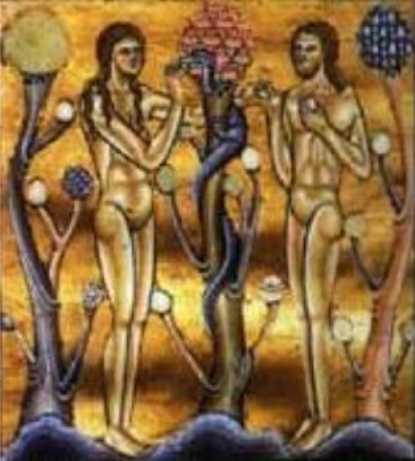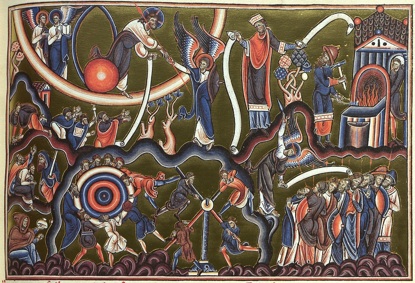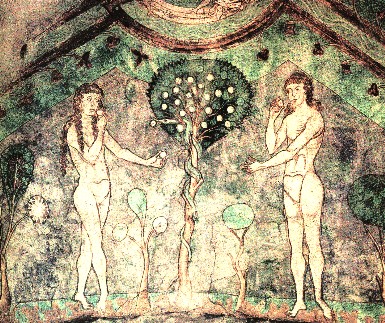Entheogenic Revelation: The Paris Eadwine Psalter
By: John Lash
From: MetaHistory.org

As I originally conceived it, PARADISE DENIED was not intended to plead for or against the Wasson thesis. My aim was to challenge the longstanding taboo on ecstatic religious experience, explain why this taboo was imposed in the first place, and consider the massive pathological impact of forbidding access to the divine dimension of the natural world. To do this, I set out to define the thesis, trace its development, its role in the psychedelic movement of the 1960s, its current ramifications, and let the evidence speak for itself. And the evidence is spectacular. The centerpiece of entheogenic theory in my proposed book was the Paris Eadwine Psalter, BNF Latin MS 8846, a rare illuminated book of the 12th Century. Biblical scenes in the psalter depict in botanically distinct form the “forbidden fruit,” blue-staining psilocybe mushrooms sprouting from the Tree of Knowledge, and other varieties of psychoactive fungi.
The above image is one of twelve sections from a full-page panel of the Eadwine MS. The psalter opens with five such panels, lavish in detail and color, and there are three other full-page panels as well, though not all of them show entheobotanical imagery. About forty other images in the 357-page MS repeat the motif of the paradisical tree, often shown in the explicit, literal form of a blue-staining mushroom.
In one panel Jesus presides over four botanically distinct types of psycho-active mushrooms, including those that stain blue (right). This startling image, in which the Christian Savior appears to invite the faithful to partake in a sacramental mushroom mass, has appeared on some entheogenic sites on the Internet, wrongly identified as belonging to the Canterbury Psalter.
To my knowledge, there exist three closely related psalters dated around 1150 CE. The Great Canterbury Psalter (Anglo-Catalan Psalter), also kept in Paris, is sometimes identified with the Paris Eadwine Psalter. The Eadwine Psalter, MS R. 17. 1, kept at Trinity College, Cambridge, can also be mistaken for BNF Latin MS 8846 which is, to my knowledge, the sole and unique example of such lavish entheobotanical imagery that survives. I have examined a book reproduction of the Cambridge MS and find many parallels but no imagery comparable to the Paris MS. Eadwine ("generous friend") is the name assigned to the Medieval scribe believed to be responsible for these masterpieces. It appears that scholars attach the same quasi-historical person to all three 12th century Psalters.
Until now, the Paris Eadwine Psalter has been studiously ignored by scholars who (as far as I can tell) make no comment on the blatant psychedelic images used to illustrate Biblical narratives. The graphic contents of the MS are totally unknown to the general public. My secondary aim in PARADISE DENIED was to introduce this astonishing book to the world.
The images in the Paris Eadwine Psalter are stunning, explicit, and unmistakable. They require no squinting and speculation, as occurs with esoteric doctrines allegedly encoded in great works of art. This one-of-a-kind manuscript presents vivid evidence in support of the Wasson thesis.
Currently, there is a rapidly growing body of research confirming Wasson's views, but nothing accessible to mainstream interest. PARADISE DENIED was intended to be the taboo-breaker to follow The Da Vinci Code — with comparable, if not considerably higher, potential for shock value.
I have not seen the original BNF Latin MS 8846—special permission is required to access and handle it—but I have closely studied the microfilm in the library archives. Some illustrations show an elaborate proliferation of mushrooms and elegantly branched mushroom-trees, recalling the surrealism of Dali's paintings. Additional to the literal, botanically identifiable images are many examples of what I call the omphalos-bud: consider what looks like a blackberry behind the head of Adam in the image at the top of this page. The reddish fruit bedecking the top of the Tree of Knoweldge recalls the form of a a pomegranate with its juicy facets. The imagery presents white psilocybin heads side by side with the omphalos-bud and the promegranate motif.

The prototype of the omphalos-bud is the world navel from Delphi. As explained in the Gnostic Gallery 2, "seasoned initiates made a special rite of gazing at the omphalos stone. A peculiar braiding of knotted and bisected chromosome-like structures adorned these stones... By holding their bodily concentration steady, initiates not only saw the Light interpenetrating the omphalos, they entered it, visually. Gazing into the depths of the substantial shadowless white luminosity, they saw the molecular structure of living matter, not just the form of DNA, suggested by the cruciform seed-like nodules engraved on the omphalos, but also the peculiar kinking and twisting
of nucleic threads. This was the epiphany of the divine serpentine force to be encountered within the ornamental marble dome. Thus the omphalos, navel, was the entry point for perception of the cosmic umbilicus, navel-string, DNA-RNA."
I believe that the artistic convention of portraying psychoactive mushrooms by the omphalos-bud points directly to initiatory knowledge surving from the Mysteries into the 12th Century. The imagery of the Paris Eadwine Psalter shows both the botanical identity of sacramental mushrooms and the visionary effect they produce, extending to the perception of molecular structure. The visual evidence here confirms my statement (The Oldest Taboo in the World) that the Tree of Knowledge, source of the forbidden fruit, conferred the wisdom that opens the way to the secret of immortality, represented by the Tree of Life (in modern terms, DNA, the human genome, ontogenic and phylogenetic evolution). This is why the Tree of Knowledge had to be forbidden, but not the Tree of Life. Yet then Adam and Eve had been awakened to heightened perception by eating of the former, they had to be banished from parasidise, lest they should then access the latter. This is how I decode the Genesis myth of the two Trees.
I need to confirm the details, but my preliminary research suggests that R.Gordon Wasson and Tina may have come quite close to discovering the Paris Eadwine Psalter. During their trips to Europe, they were often assisted by European colleagues who led them to source materials. In one instance, they were shown an Edenic scene from the Utrecht Psalter (Utrecht, Germany, Universiteitsbibliotheek, MS 32/484), produced at Reims in France around 820 CE, about three centuries before the Eadwine/Canterbury psalters. As the illustration below shows, the Utrecht psalter also contains some imagery suggestive of entheobotany: the mushroom-like forms on wispy stems might be taken for psilocybin fungi. But this imagery is pale and indistinct compared to the outrageous illustrations of the Paris MS.
It is fascinating to wonder what Gordon and Tina Wasson would have made of the Paris MS had their research let them to it. Scholars today who analyze the entheobotanical psalter, without so much as a nod to its explicit imagery, often cite the Utrecht Psalter as a prototype. The logical course of investigation for the Wassons would have been from the 9th century psalter tradition to the 12th century psalters.
Typical half-page illustration from the Paris Psalter:

As I was circulating the book proposal for PARADISE DENIED, a friend asked, "What does the Paris Eadwine Psalter prove, regarding the Wasson thesis?" Well, it does not prove anything in terms of Wassons' specific claim that the primordial mushroom cult was Eurasian and probably employed fly-agaric (amanita muscaria), rather than blue-staining psilocybin mushrooms. It does prove, however, that an entheobotanical cultic tradition, possibly a remnant of the Mysteries, survived into the 12th Century in Europe and profoundly influenced (better said: subverted) the religious art of the time. Latin MS 8846 does not directly confirm Wasson, but it does confirm a more expansive model of entheogenic theory, allowing for global and botanical variations, and does so in a most spectacular manner.


4 comments:
I LOVE this blog! Keep up the great work.
I agree! great blog and lots of head-candy.
let's dialogue on a couple of points here, as i have very skeptical thoughts.
first, in hs english class the teacher tried to get us to tell her what robert frost's poem "the road not taken" meant... well, frost himself said it was literally a poem about a walk in the woods & a path he didn't take and not all this metaphorical blather others tagged on to it.
second, we had to read hemingway's the "sun also rises" and write about the symbolism. i was late w/ the paper so i sat and made up total and utter crap! and got an A no less! so much for my faith in literary criticism and it's shit-detector.
i guess i'm saying that no matter how we try to interpret art, not being there when the artist did it, we just do not know! were all the cave paintings of Little green men or folks in space helmets or just crude drawings? i wasn't there!
i once got paid to write an article on the evolution of hydrogen in the early universe for Microsoft's encarta encyclopedia. i wrote that some folks said H2 was formed this time and others this time, and the editor wrote and said "well, which was the actual date?!" DUU=UUH! like i was there? or anyone was to know?
I mean, i bet none of us can truthfully intuit - well, maybe with our entheogens to help? - what Erocx1's inspiration was when he did his new CD [which i am going to buy with my next $ influx]. so all the speculation is fun, but no cigar for accuracy.
.... i adore speculation about things like maybe Jesus was a mushroom [one of the interpretors of the dead sea scrolls has books on this-forgot his name] but that doesn't mean i have to "believe it"
remember, as Terence said:
1. do not believe;
2. do not follow;
3. do not consume and
4. do not?? i forgot.
yes - i believe entheogens have been around a loooooooong time. no, i don't think we will ever know unless you find a skelton with a dried amanita mushroom in its hand.. but does it matter? the entheogenic experience for ME - my FELT reality is not really affected by any past data.
Erocx1 - thank you for all your great stuff on this blog!!
blessings, :L
The SilentShaman
I don't see why you need to assume that this is evidence of a secret, fringe mushroom cult and that knowledge of the Mysteries somehow survived into the 12th century. There's plenty of evidence for a continuous tradition of portraying entheogens in art from antiquity through the Christian period and beyond.
TASTY STUFF! :)
I, too, am infatuated with ethnobotanical cosmological myth-history lore from traditional cultures worldwide... check out my Heaven & Earth blog!
Post a Comment